Managing Financial Resources and Decision Making - Business Finance
VerifiedAdded on 2019/12/03
|19
|5446
|123
Report
AI Summary
This report analyzes the critical aspects of managing financial resources and making informed decisions in a business context. It begins by identifying various sources of finance, such as bank loans and personal savings, and assesses their implications and suitability for different projects. The report delves into the cost analysis of different financing options, emphasizing the importance of financial planning, and the information needs of decision-makers. It further explores budgeting, unit cost calculations, and investment appraisal techniques to evaluate project viability. Finally, the report discusses the main financial statements, their formats, and the use of financial ratios for interpretation. The report aims to provide a comprehensive overview of financial management and decision-making, equipping readers with the knowledge to make sound financial choices. The report is contributed by a student and published on Desklib, a platform for students to access AI-based study tools and resources.
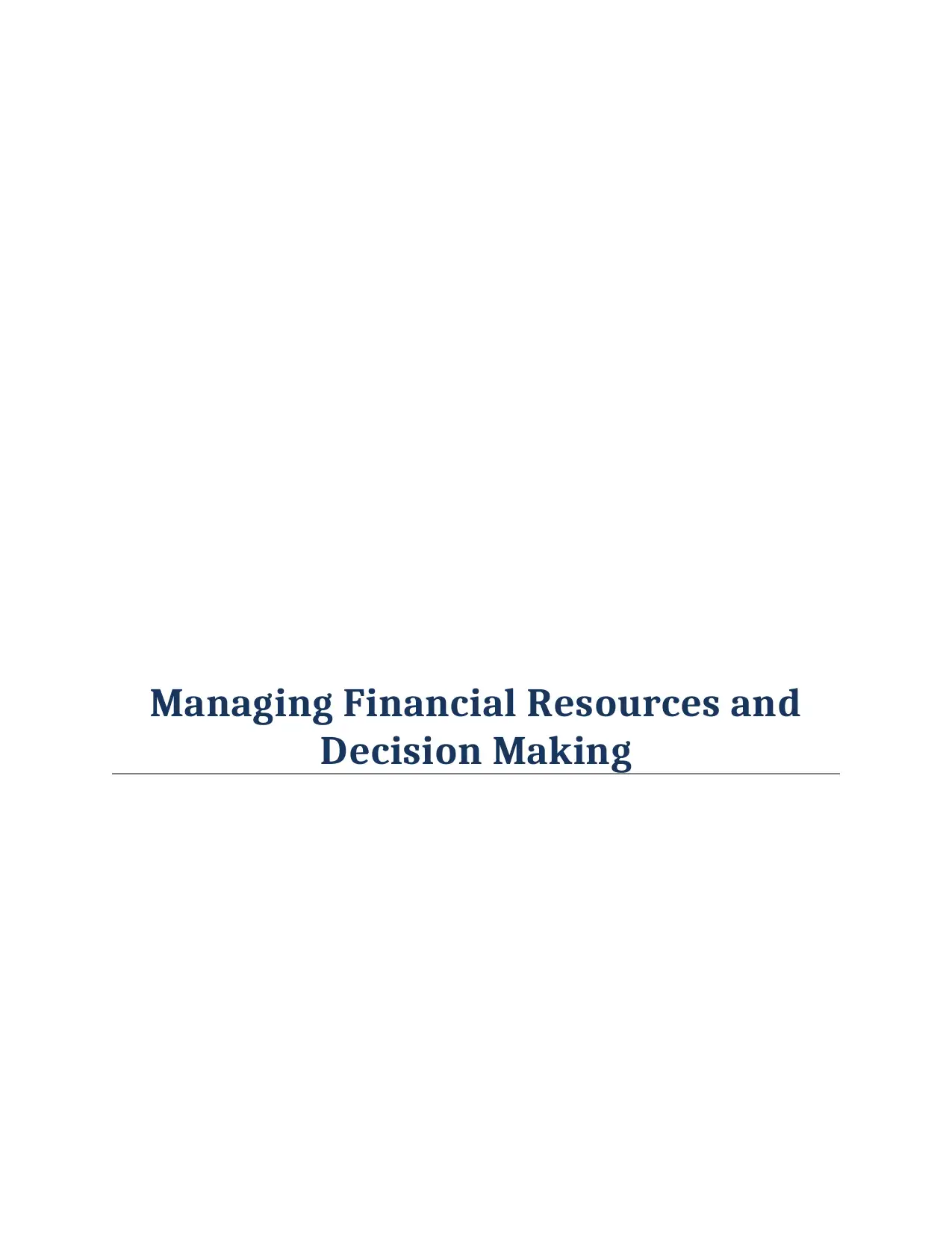
Managing Financial Resources and
Decision Making
Decision Making
Paraphrase This Document
Need a fresh take? Get an instant paraphrase of this document with our AI Paraphraser
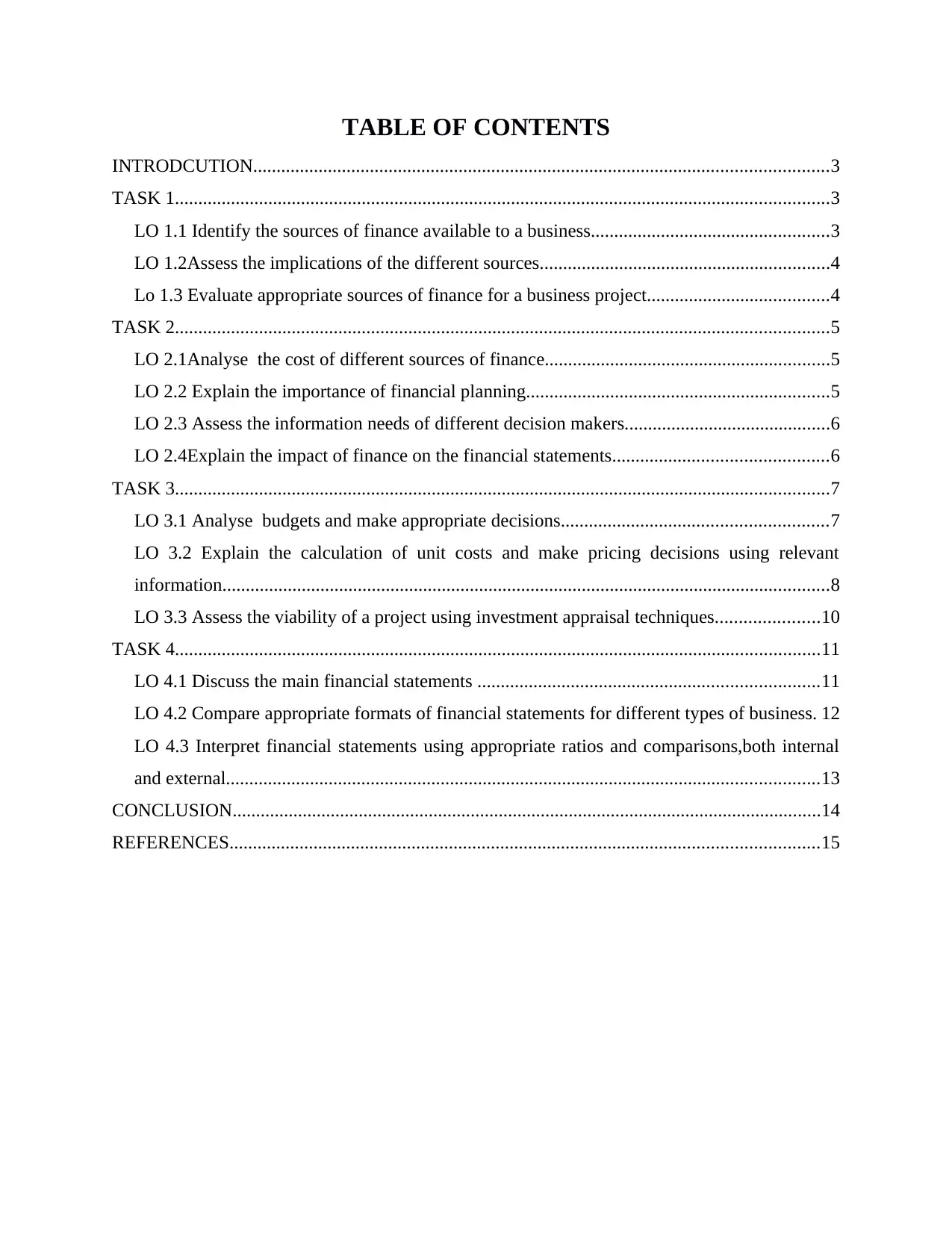
TABLE OF CONTENTS
INTRODCUTION...........................................................................................................................3
TASK 1............................................................................................................................................3
LO 1.1 Identify the sources of finance available to a business...................................................3
LO 1.2Assess the implications of the different sources..............................................................4
Lo 1.3 Evaluate appropriate sources of finance for a business project.......................................4
TASK 2............................................................................................................................................5
LO 2.1Analyse the cost of different sources of finance.............................................................5
LO 2.2 Explain the importance of financial planning.................................................................5
LO 2.3 Assess the information needs of different decision makers............................................6
LO 2.4Explain the impact of finance on the financial statements..............................................6
TASK 3............................................................................................................................................7
LO 3.1 Analyse budgets and make appropriate decisions.........................................................7
LO 3.2 Explain the calculation of unit costs and make pricing decisions using relevant
information..................................................................................................................................8
LO 3.3 Assess the viability of a project using investment appraisal techniques......................10
TASK 4..........................................................................................................................................11
LO 4.1 Discuss the main financial statements .........................................................................11
LO 4.2 Compare appropriate formats of financial statements for different types of business. 12
LO 4.3 Interpret financial statements using appropriate ratios and comparisons,both internal
and external...............................................................................................................................13
CONCLUSION..............................................................................................................................14
REFERENCES..............................................................................................................................15
INTRODCUTION...........................................................................................................................3
TASK 1............................................................................................................................................3
LO 1.1 Identify the sources of finance available to a business...................................................3
LO 1.2Assess the implications of the different sources..............................................................4
Lo 1.3 Evaluate appropriate sources of finance for a business project.......................................4
TASK 2............................................................................................................................................5
LO 2.1Analyse the cost of different sources of finance.............................................................5
LO 2.2 Explain the importance of financial planning.................................................................5
LO 2.3 Assess the information needs of different decision makers............................................6
LO 2.4Explain the impact of finance on the financial statements..............................................6
TASK 3............................................................................................................................................7
LO 3.1 Analyse budgets and make appropriate decisions.........................................................7
LO 3.2 Explain the calculation of unit costs and make pricing decisions using relevant
information..................................................................................................................................8
LO 3.3 Assess the viability of a project using investment appraisal techniques......................10
TASK 4..........................................................................................................................................11
LO 4.1 Discuss the main financial statements .........................................................................11
LO 4.2 Compare appropriate formats of financial statements for different types of business. 12
LO 4.3 Interpret financial statements using appropriate ratios and comparisons,both internal
and external...............................................................................................................................13
CONCLUSION..............................................................................................................................14
REFERENCES..............................................................................................................................15
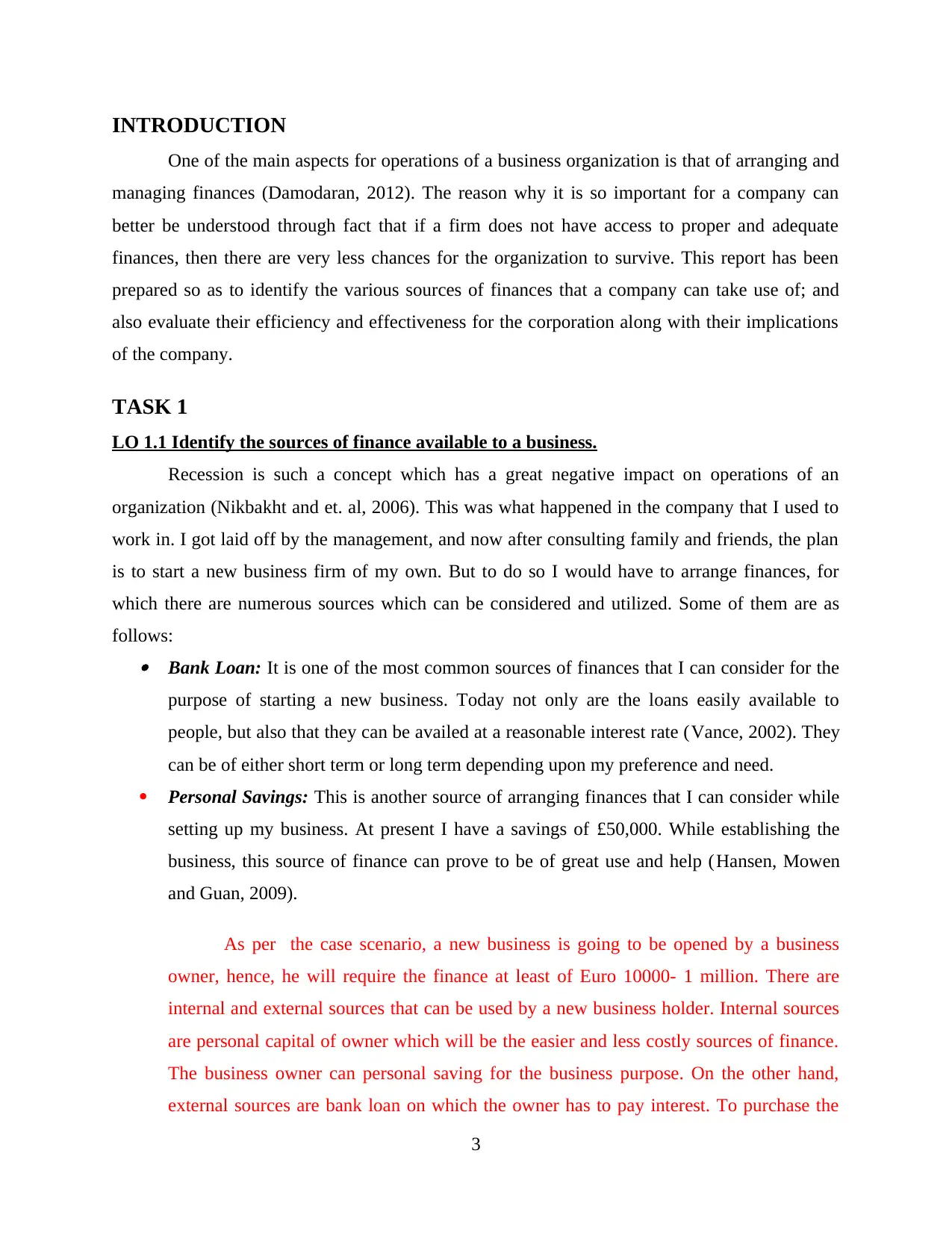
INTRODUCTION
One of the main aspects for operations of a business organization is that of arranging and
managing finances (Damodaran, 2012). The reason why it is so important for a company can
better be understood through fact that if a firm does not have access to proper and adequate
finances, then there are very less chances for the organization to survive. This report has been
prepared so as to identify the various sources of finances that a company can take use of; and
also evaluate their efficiency and effectiveness for the corporation along with their implications
of the company.
TASK 1
LO 1.1 Identify the sources of finance available to a business.
Recession is such a concept which has a great negative impact on operations of an
organization (Nikbakht and et. al, 2006). This was what happened in the company that I used to
work in. I got laid off by the management, and now after consulting family and friends, the plan
is to start a new business firm of my own. But to do so I would have to arrange finances, for
which there are numerous sources which can be considered and utilized. Some of them are as
follows: Bank Loan: It is one of the most common sources of finances that I can consider for the
purpose of starting a new business. Today not only are the loans easily available to
people, but also that they can be availed at a reasonable interest rate (Vance, 2002). They
can be of either short term or long term depending upon my preference and need.
Personal Savings: This is another source of arranging finances that I can consider while
setting up my business. At present I have a savings of £50,000. While establishing the
business, this source of finance can prove to be of great use and help (Hansen, Mowen
and Guan, 2009).
As per the case scenario, a new business is going to be opened by a business
owner, hence, he will require the finance at least of Euro 10000- 1 million. There are
internal and external sources that can be used by a new business holder. Internal sources
are personal capital of owner which will be the easier and less costly sources of finance.
The business owner can personal saving for the business purpose. On the other hand,
external sources are bank loan on which the owner has to pay interest. To purchase the
3
One of the main aspects for operations of a business organization is that of arranging and
managing finances (Damodaran, 2012). The reason why it is so important for a company can
better be understood through fact that if a firm does not have access to proper and adequate
finances, then there are very less chances for the organization to survive. This report has been
prepared so as to identify the various sources of finances that a company can take use of; and
also evaluate their efficiency and effectiveness for the corporation along with their implications
of the company.
TASK 1
LO 1.1 Identify the sources of finance available to a business.
Recession is such a concept which has a great negative impact on operations of an
organization (Nikbakht and et. al, 2006). This was what happened in the company that I used to
work in. I got laid off by the management, and now after consulting family and friends, the plan
is to start a new business firm of my own. But to do so I would have to arrange finances, for
which there are numerous sources which can be considered and utilized. Some of them are as
follows: Bank Loan: It is one of the most common sources of finances that I can consider for the
purpose of starting a new business. Today not only are the loans easily available to
people, but also that they can be availed at a reasonable interest rate (Vance, 2002). They
can be of either short term or long term depending upon my preference and need.
Personal Savings: This is another source of arranging finances that I can consider while
setting up my business. At present I have a savings of £50,000. While establishing the
business, this source of finance can prove to be of great use and help (Hansen, Mowen
and Guan, 2009).
As per the case scenario, a new business is going to be opened by a business
owner, hence, he will require the finance at least of Euro 10000- 1 million. There are
internal and external sources that can be used by a new business holder. Internal sources
are personal capital of owner which will be the easier and less costly sources of finance.
The business owner can personal saving for the business purpose. On the other hand,
external sources are bank loan on which the owner has to pay interest. To purchase the
3
⊘ This is a preview!⊘
Do you want full access?
Subscribe today to unlock all pages.

Trusted by 1+ million students worldwide
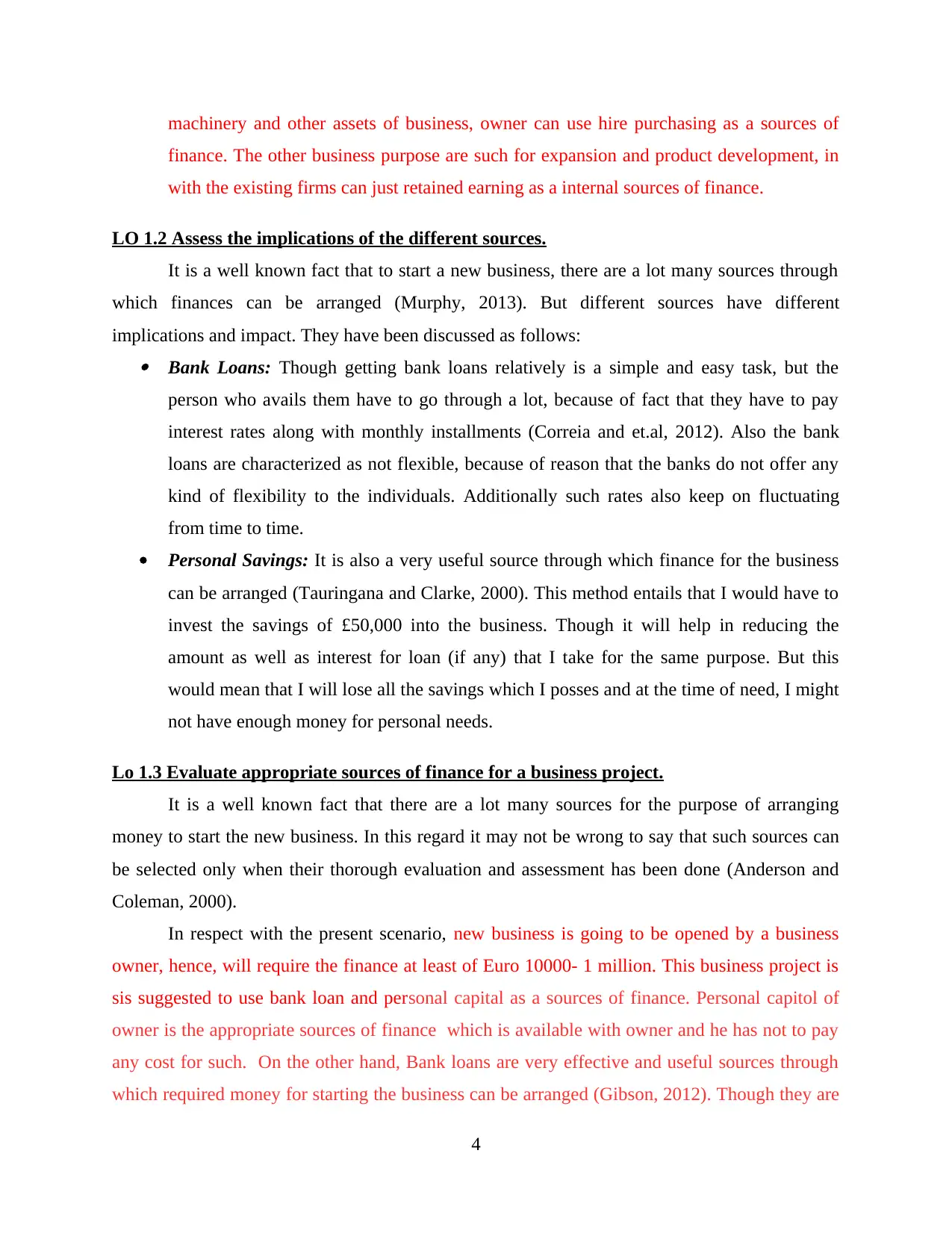
machinery and other assets of business, owner can use hire purchasing as a sources of
finance. The other business purpose are such for expansion and product development, in
with the existing firms can just retained earning as a internal sources of finance.
LO 1.2 Assess the implications of the different sources.
It is a well known fact that to start a new business, there are a lot many sources through
which finances can be arranged (Murphy, 2013). But different sources have different
implications and impact. They have been discussed as follows: Bank Loans: Though getting bank loans relatively is a simple and easy task, but the
person who avails them have to go through a lot, because of fact that they have to pay
interest rates along with monthly installments (Correia and et.al, 2012). Also the bank
loans are characterized as not flexible, because of reason that the banks do not offer any
kind of flexibility to the individuals. Additionally such rates also keep on fluctuating
from time to time.
Personal Savings: It is also a very useful source through which finance for the business
can be arranged (Tauringana and Clarke, 2000). This method entails that I would have to
invest the savings of £50,000 into the business. Though it will help in reducing the
amount as well as interest for loan (if any) that I take for the same purpose. But this
would mean that I will lose all the savings which I posses and at the time of need, I might
not have enough money for personal needs.
Lo 1.3 Evaluate appropriate sources of finance for a business project.
It is a well known fact that there are a lot many sources for the purpose of arranging
money to start the new business. In this regard it may not be wrong to say that such sources can
be selected only when their thorough evaluation and assessment has been done (Anderson and
Coleman, 2000).
In respect with the present scenario, new business is going to be opened by a business
owner, hence, will require the finance at least of Euro 10000- 1 million. This business project is
sis suggested to use bank loan and personal capital as a sources of finance. Personal capitol of
owner is the appropriate sources of finance which is available with owner and he has not to pay
any cost for such. On the other hand, Bank loans are very effective and useful sources through
which required money for starting the business can be arranged (Gibson, 2012). Though they are
4
finance. The other business purpose are such for expansion and product development, in
with the existing firms can just retained earning as a internal sources of finance.
LO 1.2 Assess the implications of the different sources.
It is a well known fact that to start a new business, there are a lot many sources through
which finances can be arranged (Murphy, 2013). But different sources have different
implications and impact. They have been discussed as follows: Bank Loans: Though getting bank loans relatively is a simple and easy task, but the
person who avails them have to go through a lot, because of fact that they have to pay
interest rates along with monthly installments (Correia and et.al, 2012). Also the bank
loans are characterized as not flexible, because of reason that the banks do not offer any
kind of flexibility to the individuals. Additionally such rates also keep on fluctuating
from time to time.
Personal Savings: It is also a very useful source through which finance for the business
can be arranged (Tauringana and Clarke, 2000). This method entails that I would have to
invest the savings of £50,000 into the business. Though it will help in reducing the
amount as well as interest for loan (if any) that I take for the same purpose. But this
would mean that I will lose all the savings which I posses and at the time of need, I might
not have enough money for personal needs.
Lo 1.3 Evaluate appropriate sources of finance for a business project.
It is a well known fact that there are a lot many sources for the purpose of arranging
money to start the new business. In this regard it may not be wrong to say that such sources can
be selected only when their thorough evaluation and assessment has been done (Anderson and
Coleman, 2000).
In respect with the present scenario, new business is going to be opened by a business
owner, hence, will require the finance at least of Euro 10000- 1 million. This business project is
sis suggested to use bank loan and personal capital as a sources of finance. Personal capitol of
owner is the appropriate sources of finance which is available with owner and he has not to pay
any cost for such. On the other hand, Bank loans are very effective and useful sources through
which required money for starting the business can be arranged (Gibson, 2012). Though they are
4
Paraphrase This Document
Need a fresh take? Get an instant paraphrase of this document with our AI Paraphraser
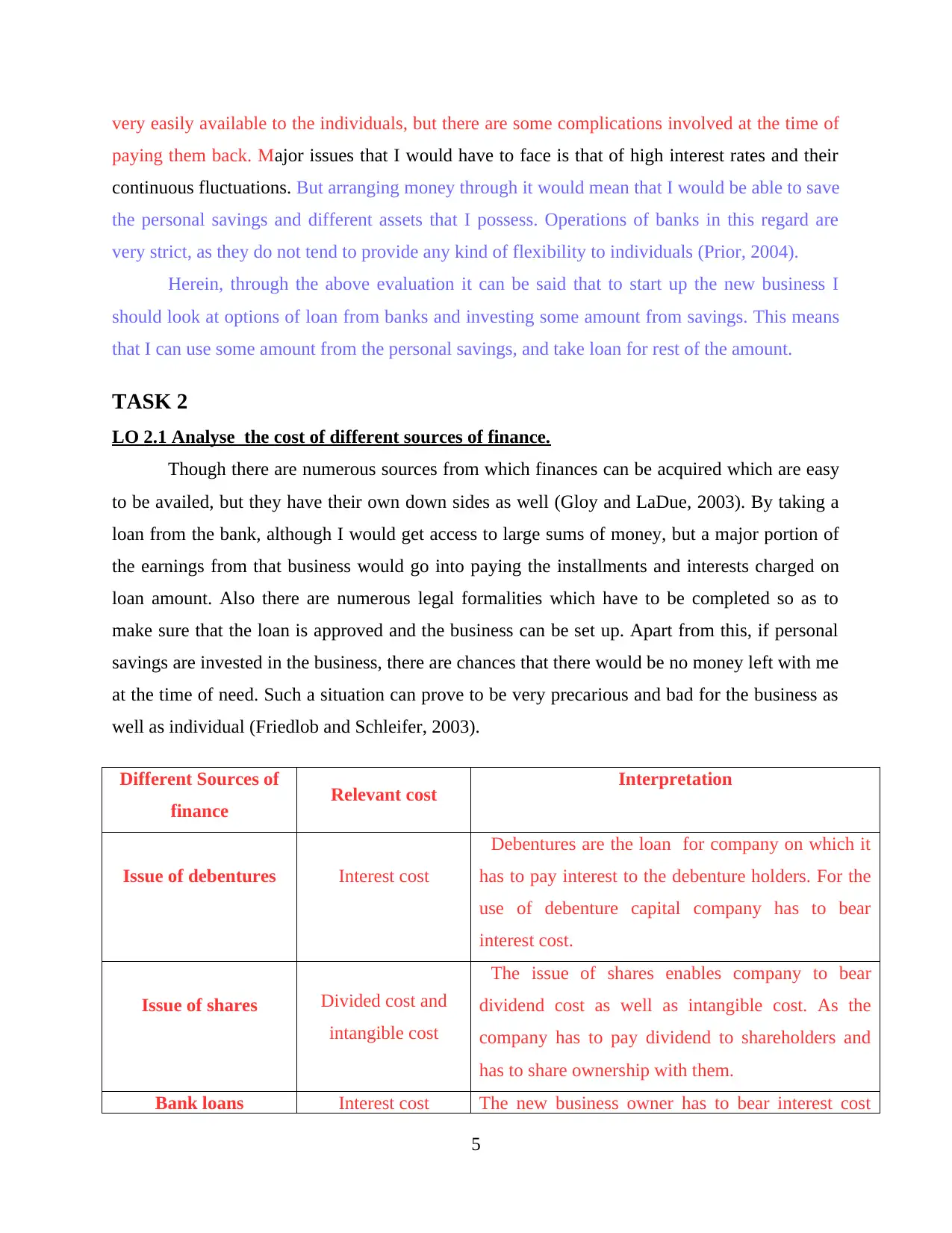
very easily available to the individuals, but there are some complications involved at the time of
paying them back. Major issues that I would have to face is that of high interest rates and their
continuous fluctuations. But arranging money through it would mean that I would be able to save
the personal savings and different assets that I possess. Operations of banks in this regard are
very strict, as they do not tend to provide any kind of flexibility to individuals (Prior, 2004).
Herein, through the above evaluation it can be said that to start up the new business I
should look at options of loan from banks and investing some amount from savings. This means
that I can use some amount from the personal savings, and take loan for rest of the amount.
TASK 2
LO 2.1 Analyse the cost of different sources of finance.
Though there are numerous sources from which finances can be acquired which are easy
to be availed, but they have their own down sides as well (Gloy and LaDue, 2003). By taking a
loan from the bank, although I would get access to large sums of money, but a major portion of
the earnings from that business would go into paying the installments and interests charged on
loan amount. Also there are numerous legal formalities which have to be completed so as to
make sure that the loan is approved and the business can be set up. Apart from this, if personal
savings are invested in the business, there are chances that there would be no money left with me
at the time of need. Such a situation can prove to be very precarious and bad for the business as
well as individual (Friedlob and Schleifer, 2003).
Different Sources of
finance Relevant cost Interpretation
Issue of debentures Interest cost
Debentures are the loan for company on which it
has to pay interest to the debenture holders. For the
use of debenture capital company has to bear
interest cost.
Issue of shares Divided cost and
intangible cost
The issue of shares enables company to bear
dividend cost as well as intangible cost. As the
company has to pay dividend to shareholders and
has to share ownership with them.
Bank loans Interest cost The new business owner has to bear interest cost
5
paying them back. Major issues that I would have to face is that of high interest rates and their
continuous fluctuations. But arranging money through it would mean that I would be able to save
the personal savings and different assets that I possess. Operations of banks in this regard are
very strict, as they do not tend to provide any kind of flexibility to individuals (Prior, 2004).
Herein, through the above evaluation it can be said that to start up the new business I
should look at options of loan from banks and investing some amount from savings. This means
that I can use some amount from the personal savings, and take loan for rest of the amount.
TASK 2
LO 2.1 Analyse the cost of different sources of finance.
Though there are numerous sources from which finances can be acquired which are easy
to be availed, but they have their own down sides as well (Gloy and LaDue, 2003). By taking a
loan from the bank, although I would get access to large sums of money, but a major portion of
the earnings from that business would go into paying the installments and interests charged on
loan amount. Also there are numerous legal formalities which have to be completed so as to
make sure that the loan is approved and the business can be set up. Apart from this, if personal
savings are invested in the business, there are chances that there would be no money left with me
at the time of need. Such a situation can prove to be very precarious and bad for the business as
well as individual (Friedlob and Schleifer, 2003).
Different Sources of
finance Relevant cost Interpretation
Issue of debentures Interest cost
Debentures are the loan for company on which it
has to pay interest to the debenture holders. For the
use of debenture capital company has to bear
interest cost.
Issue of shares Divided cost and
intangible cost
The issue of shares enables company to bear
dividend cost as well as intangible cost. As the
company has to pay dividend to shareholders and
has to share ownership with them.
Bank loans Interest cost The new business owner has to bear interest cost
5
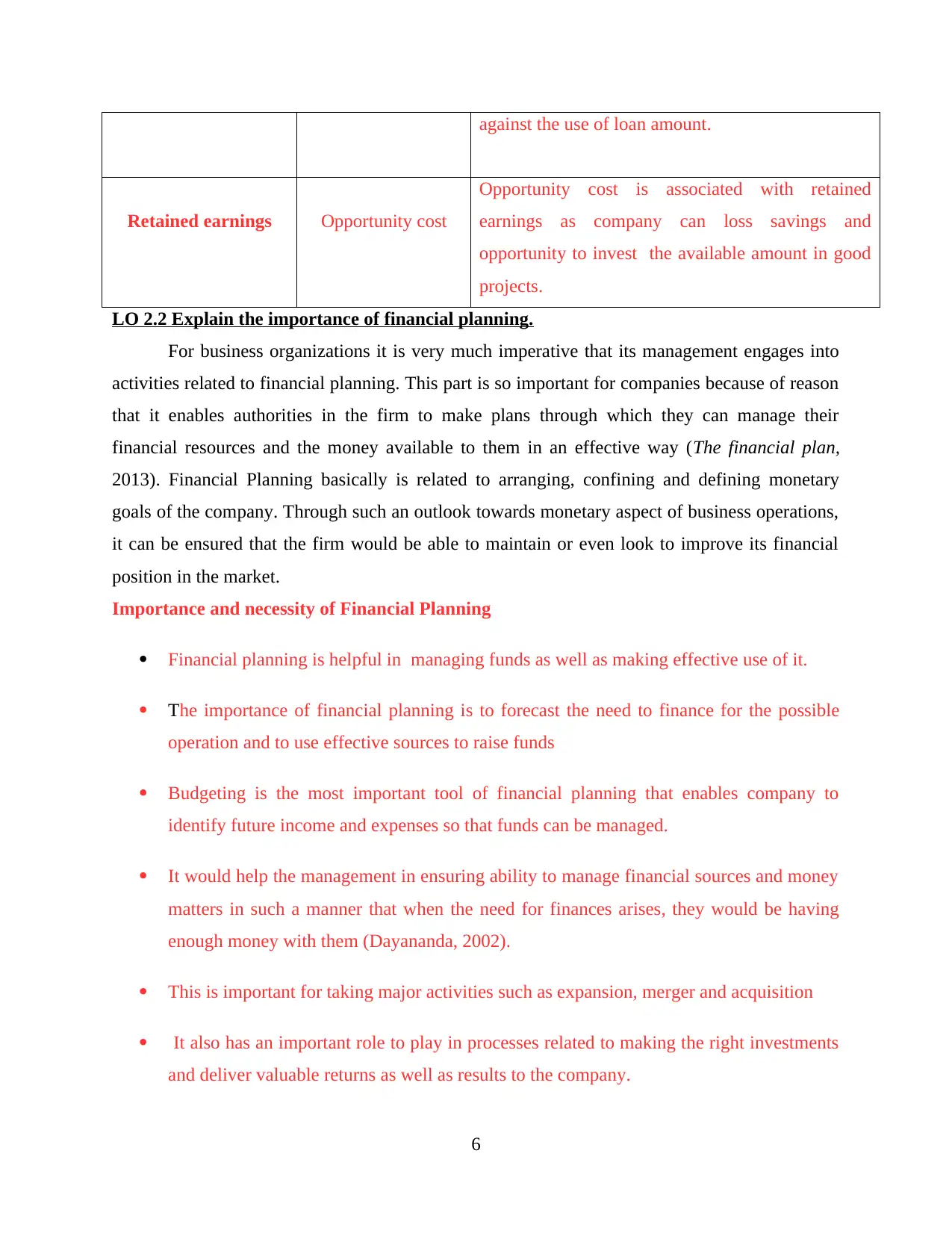
against the use of loan amount.
Retained earnings Opportunity cost
Opportunity cost is associated with retained
earnings as company can loss savings and
opportunity to invest the available amount in good
projects.
LO 2.2 Explain the importance of financial planning.
For business organizations it is very much imperative that its management engages into
activities related to financial planning. This part is so important for companies because of reason
that it enables authorities in the firm to make plans through which they can manage their
financial resources and the money available to them in an effective way (The financial plan,
2013). Financial Planning basically is related to arranging, confining and defining monetary
goals of the company. Through such an outlook towards monetary aspect of business operations,
it can be ensured that the firm would be able to maintain or even look to improve its financial
position in the market.
Importance and necessity of Financial Planning
Financial planning is helpful in managing funds as well as making effective use of it.
The importance of financial planning is to forecast the need to finance for the possible
operation and to use effective sources to raise funds
Budgeting is the most important tool of financial planning that enables company to
identify future income and expenses so that funds can be managed.
It would help the management in ensuring ability to manage financial sources and money
matters in such a manner that when the need for finances arises, they would be having
enough money with them (Dayananda, 2002).
This is important for taking major activities such as expansion, merger and acquisition
It also has an important role to play in processes related to making the right investments
and deliver valuable returns as well as results to the company.
6
Retained earnings Opportunity cost
Opportunity cost is associated with retained
earnings as company can loss savings and
opportunity to invest the available amount in good
projects.
LO 2.2 Explain the importance of financial planning.
For business organizations it is very much imperative that its management engages into
activities related to financial planning. This part is so important for companies because of reason
that it enables authorities in the firm to make plans through which they can manage their
financial resources and the money available to them in an effective way (The financial plan,
2013). Financial Planning basically is related to arranging, confining and defining monetary
goals of the company. Through such an outlook towards monetary aspect of business operations,
it can be ensured that the firm would be able to maintain or even look to improve its financial
position in the market.
Importance and necessity of Financial Planning
Financial planning is helpful in managing funds as well as making effective use of it.
The importance of financial planning is to forecast the need to finance for the possible
operation and to use effective sources to raise funds
Budgeting is the most important tool of financial planning that enables company to
identify future income and expenses so that funds can be managed.
It would help the management in ensuring ability to manage financial sources and money
matters in such a manner that when the need for finances arises, they would be having
enough money with them (Dayananda, 2002).
This is important for taking major activities such as expansion, merger and acquisition
It also has an important role to play in processes related to making the right investments
and deliver valuable returns as well as results to the company.
6
⊘ This is a preview!⊘
Do you want full access?
Subscribe today to unlock all pages.

Trusted by 1+ million students worldwide
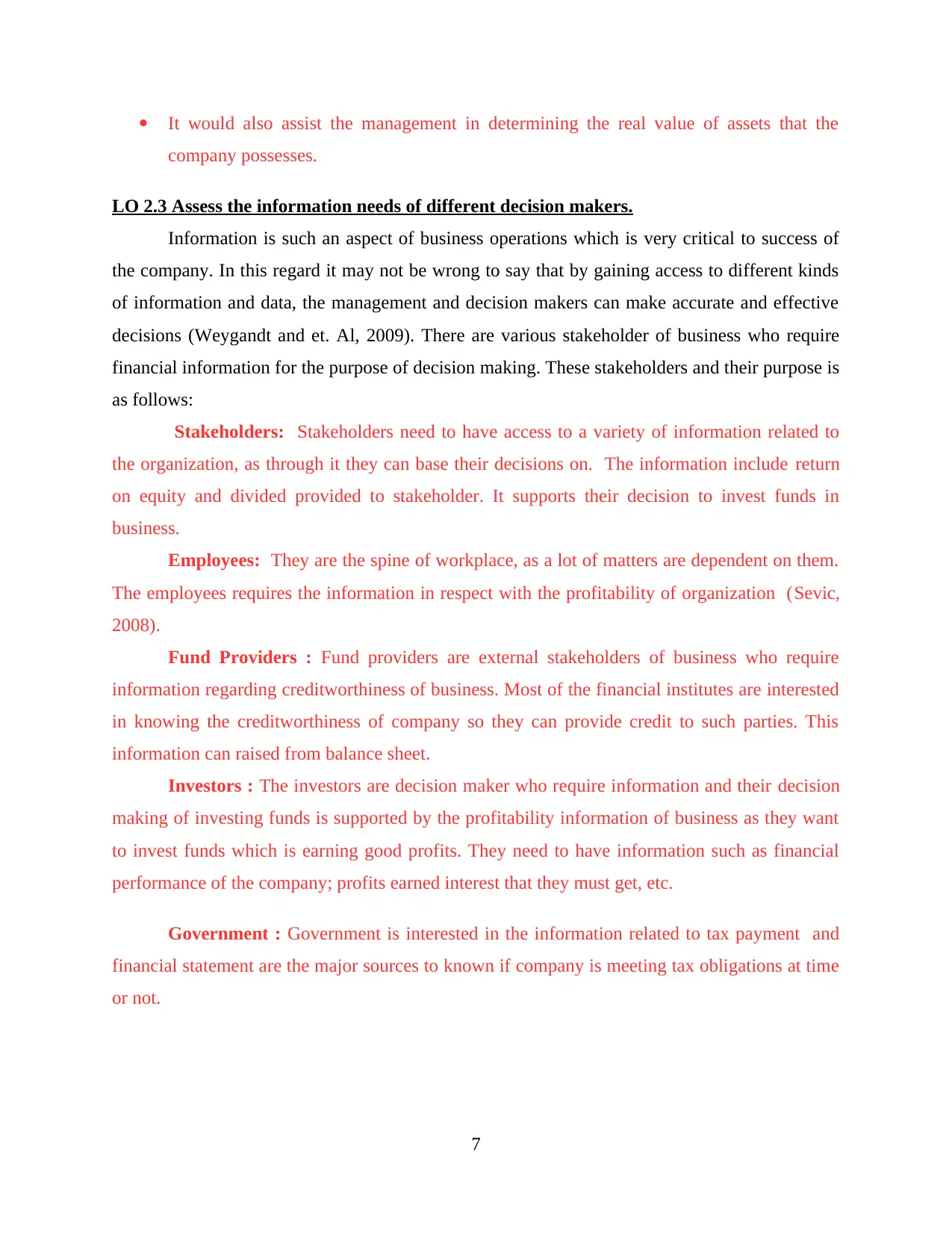
It would also assist the management in determining the real value of assets that the
company possesses.
LO 2.3 Assess the information needs of different decision makers.
Information is such an aspect of business operations which is very critical to success of
the company. In this regard it may not be wrong to say that by gaining access to different kinds
of information and data, the management and decision makers can make accurate and effective
decisions (Weygandt and et. Al, 2009). There are various stakeholder of business who require
financial information for the purpose of decision making. These stakeholders and their purpose is
as follows:
Stakeholders: Stakeholders need to have access to a variety of information related to
the organization, as through it they can base their decisions on. The information include return
on equity and divided provided to stakeholder. It supports their decision to invest funds in
business.
Employees: They are the spine of workplace, as a lot of matters are dependent on them.
The employees requires the information in respect with the profitability of organization (Sevic,
2008).
Fund Providers : Fund providers are external stakeholders of business who require
information regarding creditworthiness of business. Most of the financial institutes are interested
in knowing the creditworthiness of company so they can provide credit to such parties. This
information can raised from balance sheet.
Investors : The investors are decision maker who require information and their decision
making of investing funds is supported by the profitability information of business as they want
to invest funds which is earning good profits. They need to have information such as financial
performance of the company; profits earned interest that they must get, etc.
Government : Government is interested in the information related to tax payment and
financial statement are the major sources to known if company is meeting tax obligations at time
or not.
7
company possesses.
LO 2.3 Assess the information needs of different decision makers.
Information is such an aspect of business operations which is very critical to success of
the company. In this regard it may not be wrong to say that by gaining access to different kinds
of information and data, the management and decision makers can make accurate and effective
decisions (Weygandt and et. Al, 2009). There are various stakeholder of business who require
financial information for the purpose of decision making. These stakeholders and their purpose is
as follows:
Stakeholders: Stakeholders need to have access to a variety of information related to
the organization, as through it they can base their decisions on. The information include return
on equity and divided provided to stakeholder. It supports their decision to invest funds in
business.
Employees: They are the spine of workplace, as a lot of matters are dependent on them.
The employees requires the information in respect with the profitability of organization (Sevic,
2008).
Fund Providers : Fund providers are external stakeholders of business who require
information regarding creditworthiness of business. Most of the financial institutes are interested
in knowing the creditworthiness of company so they can provide credit to such parties. This
information can raised from balance sheet.
Investors : The investors are decision maker who require information and their decision
making of investing funds is supported by the profitability information of business as they want
to invest funds which is earning good profits. They need to have information such as financial
performance of the company; profits earned interest that they must get, etc.
Government : Government is interested in the information related to tax payment and
financial statement are the major sources to known if company is meeting tax obligations at time
or not.
7
Paraphrase This Document
Need a fresh take? Get an instant paraphrase of this document with our AI Paraphraser
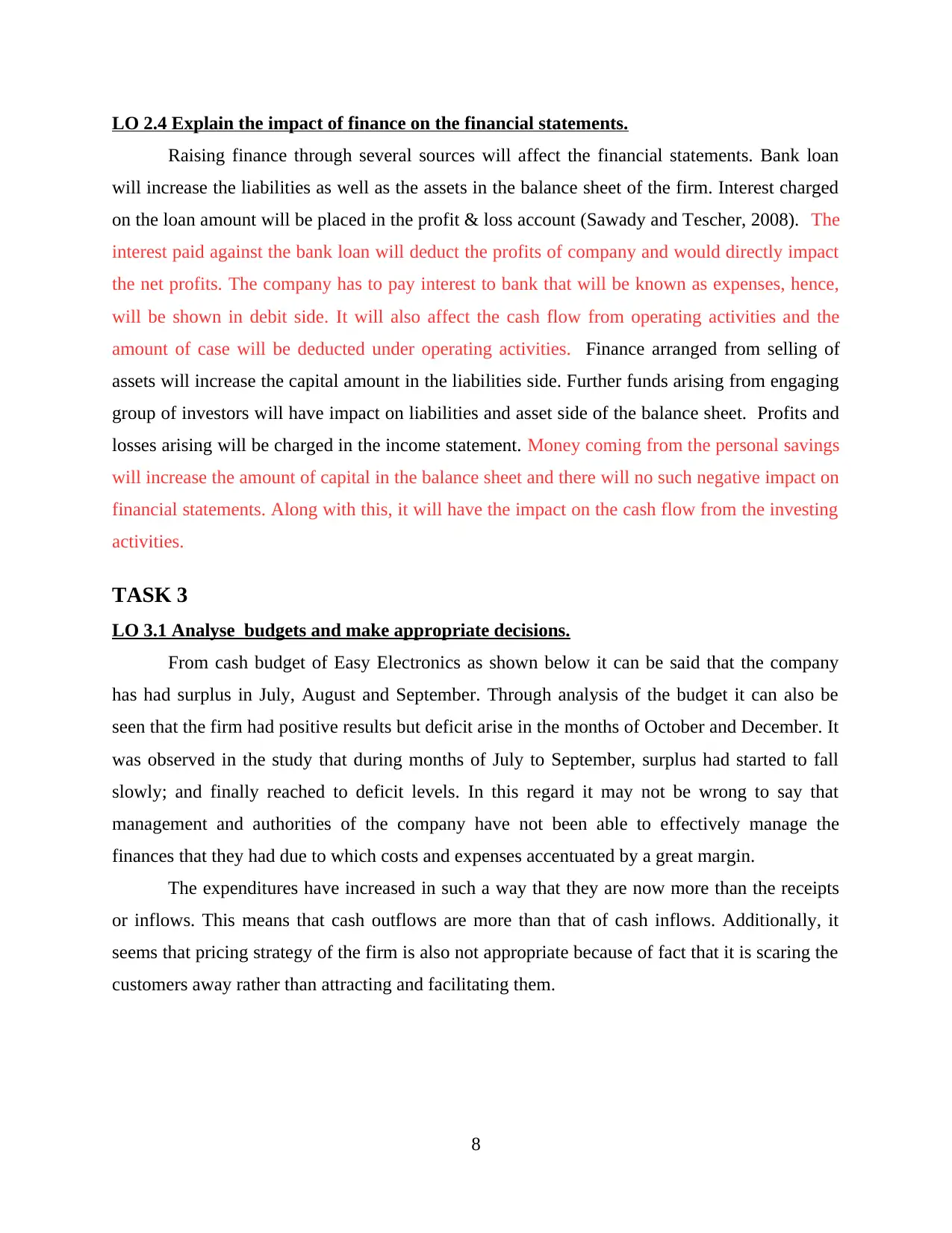
LO 2.4 Explain the impact of finance on the financial statements.
Raising finance through several sources will affect the financial statements. Bank loan
will increase the liabilities as well as the assets in the balance sheet of the firm. Interest charged
on the loan amount will be placed in the profit & loss account (Sawady and Tescher, 2008). The
interest paid against the bank loan will deduct the profits of company and would directly impact
the net profits. The company has to pay interest to bank that will be known as expenses, hence,
will be shown in debit side. It will also affect the cash flow from operating activities and the
amount of case will be deducted under operating activities. Finance arranged from selling of
assets will increase the capital amount in the liabilities side. Further funds arising from engaging
group of investors will have impact on liabilities and asset side of the balance sheet. Profits and
losses arising will be charged in the income statement. Money coming from the personal savings
will increase the amount of capital in the balance sheet and there will no such negative impact on
financial statements. Along with this, it will have the impact on the cash flow from the investing
activities.
TASK 3
LO 3.1 Analyse budgets and make appropriate decisions.
From cash budget of Easy Electronics as shown below it can be said that the company
has had surplus in July, August and September. Through analysis of the budget it can also be
seen that the firm had positive results but deficit arise in the months of October and December. It
was observed in the study that during months of July to September, surplus had started to fall
slowly; and finally reached to deficit levels. In this regard it may not be wrong to say that
management and authorities of the company have not been able to effectively manage the
finances that they had due to which costs and expenses accentuated by a great margin.
The expenditures have increased in such a way that they are now more than the receipts
or inflows. This means that cash outflows are more than that of cash inflows. Additionally, it
seems that pricing strategy of the firm is also not appropriate because of fact that it is scaring the
customers away rather than attracting and facilitating them.
8
Raising finance through several sources will affect the financial statements. Bank loan
will increase the liabilities as well as the assets in the balance sheet of the firm. Interest charged
on the loan amount will be placed in the profit & loss account (Sawady and Tescher, 2008). The
interest paid against the bank loan will deduct the profits of company and would directly impact
the net profits. The company has to pay interest to bank that will be known as expenses, hence,
will be shown in debit side. It will also affect the cash flow from operating activities and the
amount of case will be deducted under operating activities. Finance arranged from selling of
assets will increase the capital amount in the liabilities side. Further funds arising from engaging
group of investors will have impact on liabilities and asset side of the balance sheet. Profits and
losses arising will be charged in the income statement. Money coming from the personal savings
will increase the amount of capital in the balance sheet and there will no such negative impact on
financial statements. Along with this, it will have the impact on the cash flow from the investing
activities.
TASK 3
LO 3.1 Analyse budgets and make appropriate decisions.
From cash budget of Easy Electronics as shown below it can be said that the company
has had surplus in July, August and September. Through analysis of the budget it can also be
seen that the firm had positive results but deficit arise in the months of October and December. It
was observed in the study that during months of July to September, surplus had started to fall
slowly; and finally reached to deficit levels. In this regard it may not be wrong to say that
management and authorities of the company have not been able to effectively manage the
finances that they had due to which costs and expenses accentuated by a great margin.
The expenditures have increased in such a way that they are now more than the receipts
or inflows. This means that cash outflows are more than that of cash inflows. Additionally, it
seems that pricing strategy of the firm is also not appropriate because of fact that it is scaring the
customers away rather than attracting and facilitating them.
8
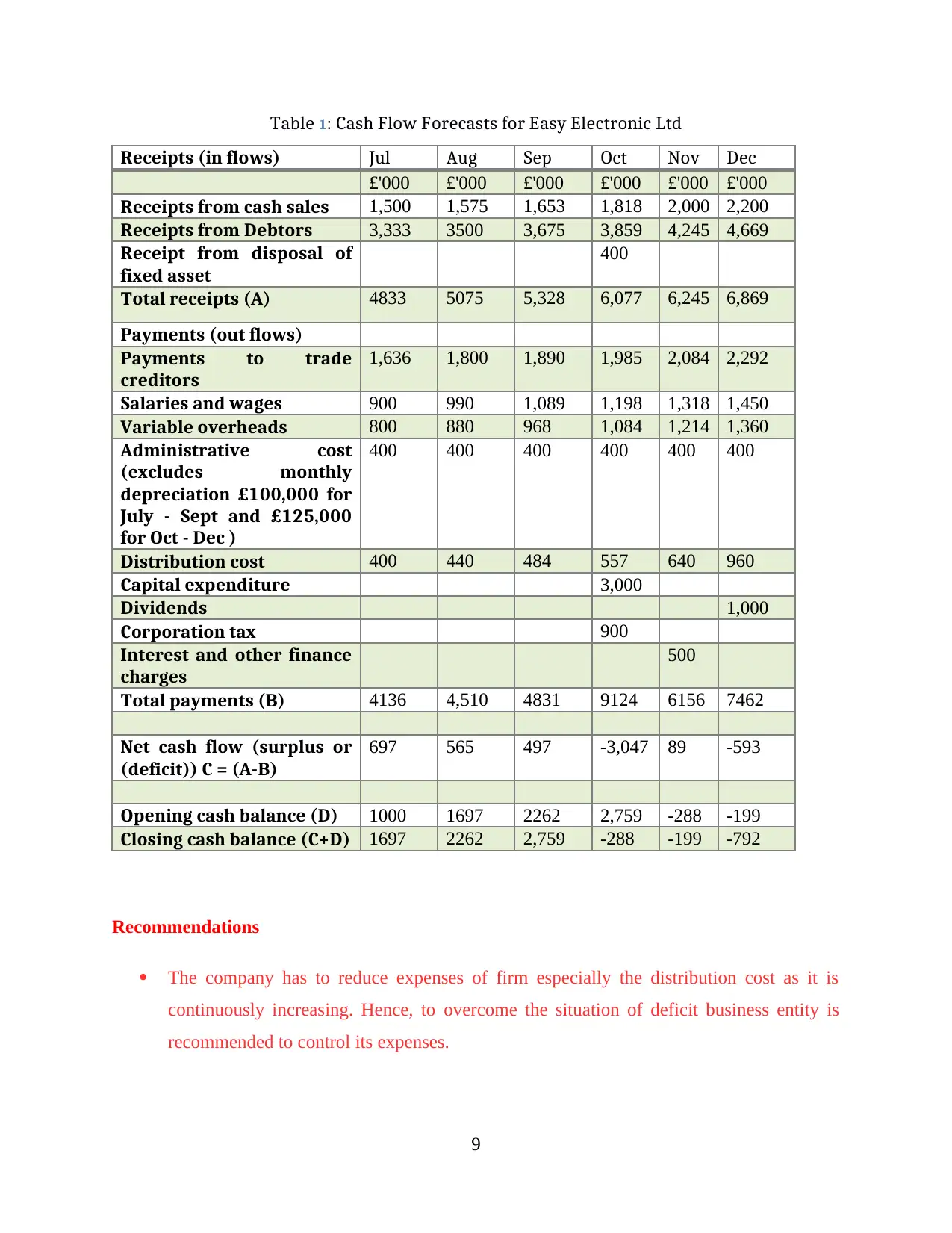
Table 1: Cash Flow Forecasts for Easy Electronic Ltd
Receipts (in flows) Jul Aug Sep Oct Nov Dec
£'000 £'000 £'000 £'000 £'000 £'000
Receipts from cash sales 1,500 1,575 1,653 1,818 2,000 2,200
Receipts from Debtors 3,333 3500 3,675 3,859 4,245 4,669
Receipt from disposal of
fixed asset
400
Total receipts (A) 4833 5075 5,328 6,077 6,245 6,869
Payments (out flows)
Payments to trade
creditors
1,636 1,800 1,890 1,985 2,084 2,292
Salaries and wages 900 990 1,089 1,198 1,318 1,450
Variable overheads 800 880 968 1,084 1,214 1,360
Administrative cost
(excludes monthly
depreciation £100,000 for
July - Sept and £125,000
for Oct - Dec )
400 400 400 400 400 400
Distribution cost 400 440 484 557 640 960
Capital expenditure 3,000
Dividends 1,000
Corporation tax 900
Interest and other finance
charges
500
Total payments (B) 4136 4,510 4831 9124 6156 7462
Net cash flow (surplus or
(deficit)) C = (A-B)
697 565 497 -3,047 89 -593
Opening cash balance (D) 1000 1697 2262 2,759 -288 -199
Closing cash balance (C+D) 1697 2262 2,759 -288 -199 -792
Recommendations
The company has to reduce expenses of firm especially the distribution cost as it is
continuously increasing. Hence, to overcome the situation of deficit business entity is
recommended to control its expenses.
9
Receipts (in flows) Jul Aug Sep Oct Nov Dec
£'000 £'000 £'000 £'000 £'000 £'000
Receipts from cash sales 1,500 1,575 1,653 1,818 2,000 2,200
Receipts from Debtors 3,333 3500 3,675 3,859 4,245 4,669
Receipt from disposal of
fixed asset
400
Total receipts (A) 4833 5075 5,328 6,077 6,245 6,869
Payments (out flows)
Payments to trade
creditors
1,636 1,800 1,890 1,985 2,084 2,292
Salaries and wages 900 990 1,089 1,198 1,318 1,450
Variable overheads 800 880 968 1,084 1,214 1,360
Administrative cost
(excludes monthly
depreciation £100,000 for
July - Sept and £125,000
for Oct - Dec )
400 400 400 400 400 400
Distribution cost 400 440 484 557 640 960
Capital expenditure 3,000
Dividends 1,000
Corporation tax 900
Interest and other finance
charges
500
Total payments (B) 4136 4,510 4831 9124 6156 7462
Net cash flow (surplus or
(deficit)) C = (A-B)
697 565 497 -3,047 89 -593
Opening cash balance (D) 1000 1697 2262 2,759 -288 -199
Closing cash balance (C+D) 1697 2262 2,759 -288 -199 -792
Recommendations
The company has to reduce expenses of firm especially the distribution cost as it is
continuously increasing. Hence, to overcome the situation of deficit business entity is
recommended to control its expenses.
9
⊘ This is a preview!⊘
Do you want full access?
Subscribe today to unlock all pages.

Trusted by 1+ million students worldwide
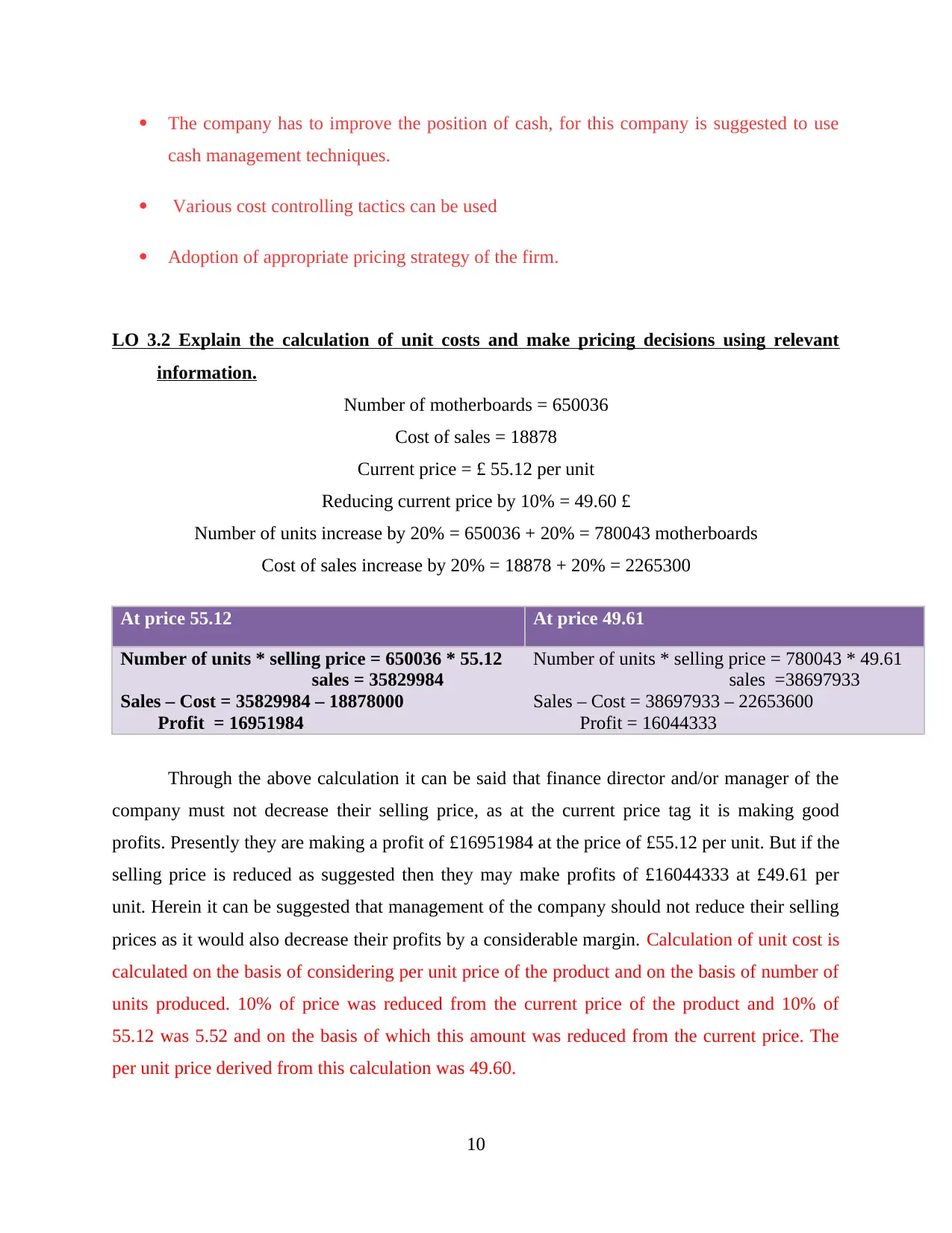
The company has to improve the position of cash, for this company is suggested to use
cash management techniques.
Various cost controlling tactics can be used
Adoption of appropriate pricing strategy of the firm.
LO 3.2 Explain the calculation of unit costs and make pricing decisions using relevant
information.
Number of motherboards = 650036
Cost of sales = 18878
Current price = £ 55.12 per unit
Reducing current price by 10% = 49.60 £
Number of units increase by 20% = 650036 + 20% = 780043 motherboards
Cost of sales increase by 20% = 18878 + 20% = 2265300
At price 55.12 At price 49.61
Number of units * selling price = 650036 * 55.12
sales = 35829984
Sales – Cost = 35829984 – 18878000
Profit = 16951984
Number of units * selling price = 780043 * 49.61
sales =38697933
Sales – Cost = 38697933 – 22653600
Profit = 16044333
Through the above calculation it can be said that finance director and/or manager of the
company must not decrease their selling price, as at the current price tag it is making good
profits. Presently they are making a profit of £16951984 at the price of £55.12 per unit. But if the
selling price is reduced as suggested then they may make profits of £16044333 at £49.61 per
unit. Herein it can be suggested that management of the company should not reduce their selling
prices as it would also decrease their profits by a considerable margin. Calculation of unit cost is
calculated on the basis of considering per unit price of the product and on the basis of number of
units produced. 10% of price was reduced from the current price of the product and 10% of
55.12 was 5.52 and on the basis of which this amount was reduced from the current price. The
per unit price derived from this calculation was 49.60.
10
cash management techniques.
Various cost controlling tactics can be used
Adoption of appropriate pricing strategy of the firm.
LO 3.2 Explain the calculation of unit costs and make pricing decisions using relevant
information.
Number of motherboards = 650036
Cost of sales = 18878
Current price = £ 55.12 per unit
Reducing current price by 10% = 49.60 £
Number of units increase by 20% = 650036 + 20% = 780043 motherboards
Cost of sales increase by 20% = 18878 + 20% = 2265300
At price 55.12 At price 49.61
Number of units * selling price = 650036 * 55.12
sales = 35829984
Sales – Cost = 35829984 – 18878000
Profit = 16951984
Number of units * selling price = 780043 * 49.61
sales =38697933
Sales – Cost = 38697933 – 22653600
Profit = 16044333
Through the above calculation it can be said that finance director and/or manager of the
company must not decrease their selling price, as at the current price tag it is making good
profits. Presently they are making a profit of £16951984 at the price of £55.12 per unit. But if the
selling price is reduced as suggested then they may make profits of £16044333 at £49.61 per
unit. Herein it can be suggested that management of the company should not reduce their selling
prices as it would also decrease their profits by a considerable margin. Calculation of unit cost is
calculated on the basis of considering per unit price of the product and on the basis of number of
units produced. 10% of price was reduced from the current price of the product and 10% of
55.12 was 5.52 and on the basis of which this amount was reduced from the current price. The
per unit price derived from this calculation was 49.60.
10
Paraphrase This Document
Need a fresh take? Get an instant paraphrase of this document with our AI Paraphraser
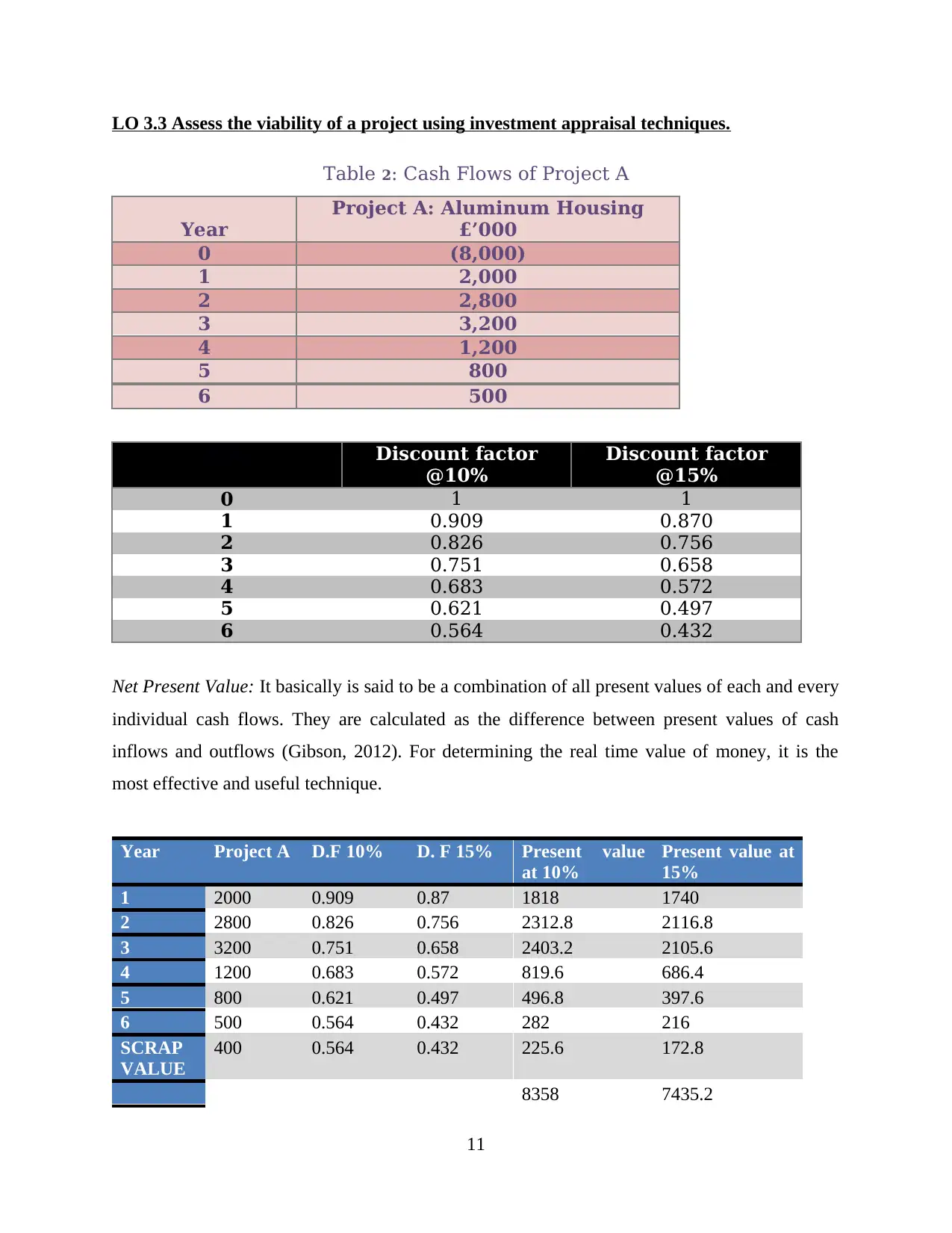
LO 3.3 Assess the viability of a project using investment appraisal techniques.
Table 2: Cash Flows of Project A
Year
Project A: Aluminum Housing
£’000
0 (8,000)
1 2,000
2 2,800
3 3,200
4 1,200
5 800
6 500
Year Discount factor
@10%
Discount factor
@15%
0 1 1
1 0.909 0.870
2 0.826 0.756
3 0.751 0.658
4 0.683 0.572
5 0.621 0.497
6 0.564 0.432
Net Present Value: It basically is said to be a combination of all present values of each and every
individual cash flows. They are calculated as the difference between present values of cash
inflows and outflows (Gibson, 2012). For determining the real time value of money, it is the
most effective and useful technique.
Table 3: Net Present Values
Year Project A D.F 10% D. F 15% Present value
at 10%
Present value at
15%
1 2000 0.909 0.87 1818 1740
2 2800 0.826 0.756 2312.8 2116.8
3 3200 0.751 0.658 2403.2 2105.6
4 1200 0.683 0.572 819.6 686.4
5 800 0.621 0.497 496.8 397.6
6 500 0.564 0.432 282 216
SCRAP
VALUE
400 0.564 0.432 225.6 172.8
8358 7435.2
11
Table 2: Cash Flows of Project A
Year
Project A: Aluminum Housing
£’000
0 (8,000)
1 2,000
2 2,800
3 3,200
4 1,200
5 800
6 500
Year Discount factor
@10%
Discount factor
@15%
0 1 1
1 0.909 0.870
2 0.826 0.756
3 0.751 0.658
4 0.683 0.572
5 0.621 0.497
6 0.564 0.432
Net Present Value: It basically is said to be a combination of all present values of each and every
individual cash flows. They are calculated as the difference between present values of cash
inflows and outflows (Gibson, 2012). For determining the real time value of money, it is the
most effective and useful technique.
Table 3: Net Present Values
Year Project A D.F 10% D. F 15% Present value
at 10%
Present value at
15%
1 2000 0.909 0.87 1818 1740
2 2800 0.826 0.756 2312.8 2116.8
3 3200 0.751 0.658 2403.2 2105.6
4 1200 0.683 0.572 819.6 686.4
5 800 0.621 0.497 496.8 397.6
6 500 0.564 0.432 282 216
SCRAP
VALUE
400 0.564 0.432 225.6 172.8
8358 7435.2
11
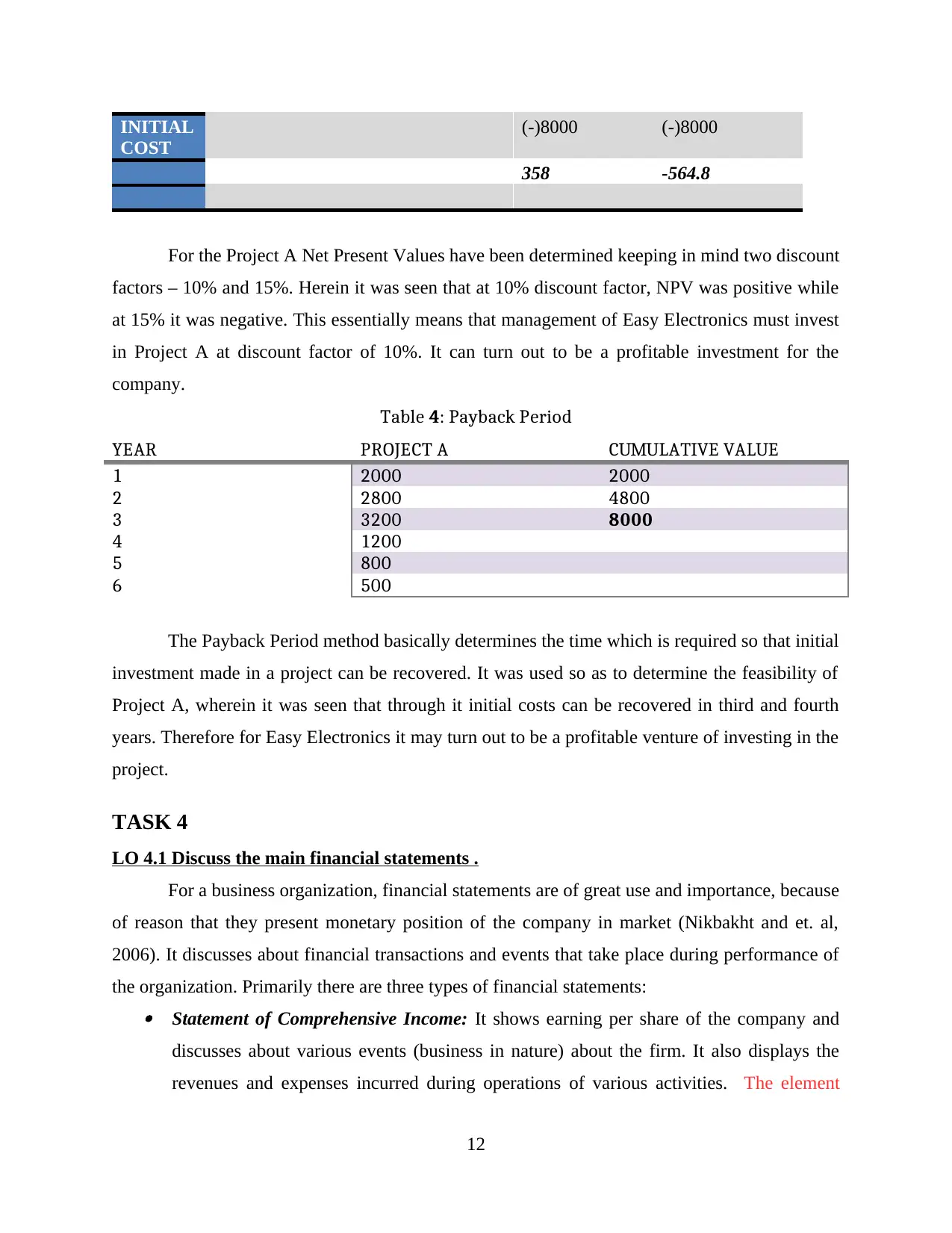
INITIAL
COST
(-)8000 (-)8000
358 -564.8
For the Project A Net Present Values have been determined keeping in mind two discount
factors – 10% and 15%. Herein it was seen that at 10% discount factor, NPV was positive while
at 15% it was negative. This essentially means that management of Easy Electronics must invest
in Project A at discount factor of 10%. It can turn out to be a profitable investment for the
company.
Table 4: Payback Period
YEAR PROJECT A CUMULATIVE VALUE
1 2000 2000
2 2800 4800
3 3200 8000
4 1200
5 800
6 500
The Payback Period method basically determines the time which is required so that initial
investment made in a project can be recovered. It was used so as to determine the feasibility of
Project A, wherein it was seen that through it initial costs can be recovered in third and fourth
years. Therefore for Easy Electronics it may turn out to be a profitable venture of investing in the
project.
TASK 4
LO 4.1 Discuss the main financial statements .
For a business organization, financial statements are of great use and importance, because
of reason that they present monetary position of the company in market (Nikbakht and et. al,
2006). It discusses about financial transactions and events that take place during performance of
the organization. Primarily there are three types of financial statements: Statement of Comprehensive Income: It shows earning per share of the company and
discusses about various events (business in nature) about the firm. It also displays the
revenues and expenses incurred during operations of various activities. The element
12
COST
(-)8000 (-)8000
358 -564.8
For the Project A Net Present Values have been determined keeping in mind two discount
factors – 10% and 15%. Herein it was seen that at 10% discount factor, NPV was positive while
at 15% it was negative. This essentially means that management of Easy Electronics must invest
in Project A at discount factor of 10%. It can turn out to be a profitable investment for the
company.
Table 4: Payback Period
YEAR PROJECT A CUMULATIVE VALUE
1 2000 2000
2 2800 4800
3 3200 8000
4 1200
5 800
6 500
The Payback Period method basically determines the time which is required so that initial
investment made in a project can be recovered. It was used so as to determine the feasibility of
Project A, wherein it was seen that through it initial costs can be recovered in third and fourth
years. Therefore for Easy Electronics it may turn out to be a profitable venture of investing in the
project.
TASK 4
LO 4.1 Discuss the main financial statements .
For a business organization, financial statements are of great use and importance, because
of reason that they present monetary position of the company in market (Nikbakht and et. al,
2006). It discusses about financial transactions and events that take place during performance of
the organization. Primarily there are three types of financial statements: Statement of Comprehensive Income: It shows earning per share of the company and
discusses about various events (business in nature) about the firm. It also displays the
revenues and expenses incurred during operations of various activities. The element
12
⊘ This is a preview!⊘
Do you want full access?
Subscribe today to unlock all pages.

Trusted by 1+ million students worldwide
1 out of 19
Related Documents
Your All-in-One AI-Powered Toolkit for Academic Success.
+13062052269
info@desklib.com
Available 24*7 on WhatsApp / Email
![[object Object]](/_next/static/media/star-bottom.7253800d.svg)
Unlock your academic potential
Copyright © 2020–2025 A2Z Services. All Rights Reserved. Developed and managed by ZUCOL.





